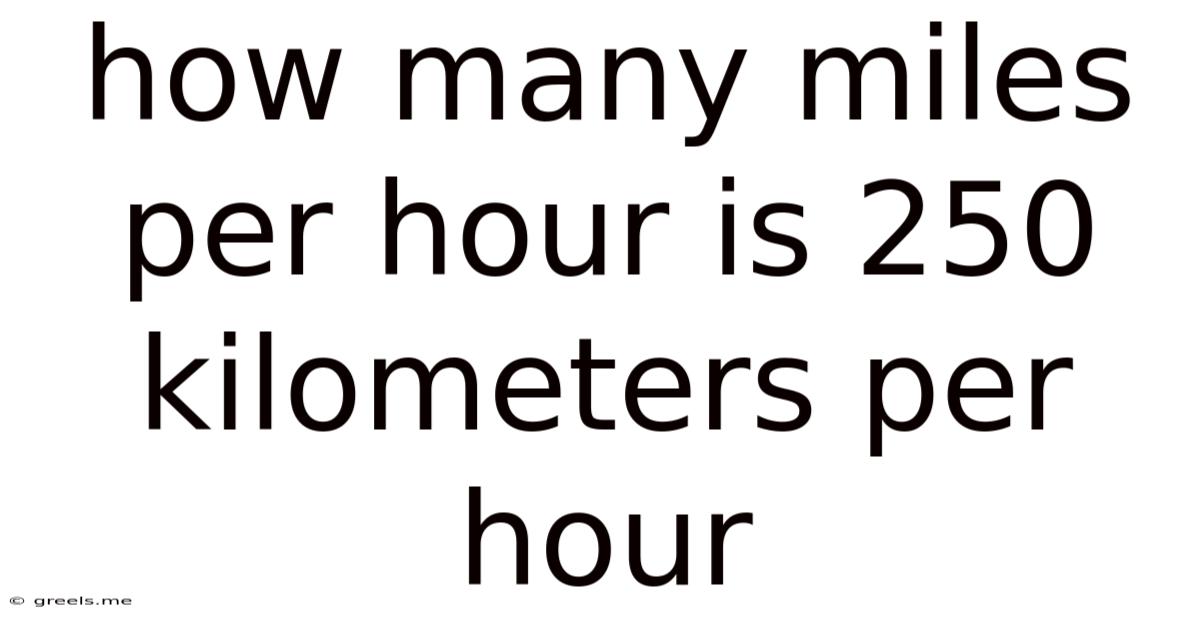How Many Miles Per Hour Is 250 Kilometers Per Hour
Greels
May 23, 2025 · 4 min read

Table of Contents
How Many Miles Per Hour is 250 Kilometers Per Hour? A Comprehensive Guide to Unit Conversion
Speed is a crucial aspect of many aspects of our lives, from driving to aviation to even tracking the speed of a cheetah. Often, we encounter speed measurements in different units, leading to confusion and the need for conversion. This comprehensive guide delves into the conversion of 250 kilometers per hour (km/h) to miles per hour (mph), offering a deep dive into the process and providing valuable context for understanding speed measurements.
Understanding the Units: Kilometers and Miles
Before diving into the conversion, let's understand the units involved.
-
Kilometers (km): A unit of length in the metric system. One kilometer is equal to 1000 meters. The metric system is widely used globally, especially in scientific contexts.
-
Miles (mi): A unit of length in the imperial system, commonly used in the United States and a few other countries. One mile is approximately equal to 1609.34 meters.
The difference between these units is significant and understanding this difference is key to accurate conversions. Simply put, a mile is longer than a kilometer.
The Conversion Process: From km/h to mph
To convert 250 km/h to mph, we need a conversion factor that relates kilometers to miles. This factor is approximately 1.60934 kilometers per mile.
Here's the calculation:
-
Start with the given value: 250 km/h
-
Apply the conversion factor: Multiply 250 km/h by the conversion factor (1 mile / 1.60934 kilometers). This cancels out the kilometers, leaving us with miles per hour.
-
Calculation: 250 km/h * (1 mile / 1.60934 km) ≈ 155.34 mph
Therefore, 250 kilometers per hour is approximately equal to 155.34 miles per hour.
Contextualizing the Speed: Real-World Examples
Understanding the speed of 250 km/h (or 155.34 mph) requires contextualization. This speed is exceptionally high in most everyday scenarios. Let's look at some examples:
Automotive Context:
-
High-performance vehicles: Some supercars and high-end sports cars can reach this speed, but only under controlled conditions and on specialized tracks. Driving at this speed on public roads is extremely dangerous and illegal in most jurisdictions.
-
Speed limits: Public road speed limits are significantly lower than 250 km/h. Even on highways, the speed limit rarely exceeds 130 km/h (approximately 80 mph) in many parts of the world.
Aviation Context:
-
Small aircraft: While some small aircraft can reach this speed, it's typically not sustained for long periods and depends on factors like wind conditions and aircraft type.
-
Commercial airliners: Commercial airliners routinely travel at significantly higher speeds, often exceeding 800 km/h (approximately 500 mph) at cruising altitude. However, this is airspeed, which differs from ground speed.
Other Applications:
-
Train travel: High-speed rail trains can approach or even exceed this speed, but again, this is specific to high-speed rail lines and not typical of all train travel.
-
Animal speed: Certain animals, like cheetahs, can briefly reach speeds in this range, showcasing their incredible athleticism.
The Importance of Accurate Conversions
Accurate conversions are crucial for several reasons:
-
Safety: In contexts like aviation and transportation, accurate speed conversions are vital for safety. Miscalculations could have severe consequences.
-
International communication: The globalized world necessitates the understanding and conversion of different measurement units for effective communication across different countries.
-
Scientific research: Accurate unit conversions are essential in scientific fields, particularly when dealing with research data and international collaboration.
-
Engineering and design: Converting between units is crucial in designing and building structures, vehicles, and other engineering projects.
Beyond the Basics: Factors Affecting Speed
It's important to understand that speed is not always a constant value. Several factors can influence speed, making accurate calculation and conversion even more important.
-
Wind speed: In aviation and other situations where wind is a factor, the actual ground speed may differ from the airspeed. Headwinds will decrease ground speed while tailwinds will increase it.
-
Terrain: The terrain can impact the speed of vehicles, especially in contexts like driving or cycling. Uphill slopes will significantly reduce speed, whereas downhill slopes will increase speed.
-
Friction and resistance: Friction and air resistance influence speed, slowing down moving objects. This is why streamlining is important for vehicles and aircraft.
-
Units of measurement: As we've already discussed, understanding and correctly converting between different units of measurement is crucial for accurate speed calculations.
Conclusion: Mastering Unit Conversion for Speed
Converting 250 kilometers per hour to miles per hour provides a clear example of the importance of accurate unit conversions. Understanding the conversion process and the context of the speed being measured is crucial for safety, efficiency, and clarity. Whether in scientific research, everyday life, or professional applications, mastering unit conversion is a valuable skill that can prevent errors and enhance understanding. While 250 km/h translates to approximately 155.34 mph, the real-world implications of this speed heavily depend on the context and should always be approached with caution and an understanding of the factors that affect speed. The application of this knowledge can increase safety and improve communication in various situations. Remember to always double-check your calculations and ensure you're using the correct conversion factors.
Latest Posts
Related Post
Thank you for visiting our website which covers about How Many Miles Per Hour Is 250 Kilometers Per Hour . We hope the information provided has been useful to you. Feel free to contact us if you have any questions or need further assistance. See you next time and don't miss to bookmark.